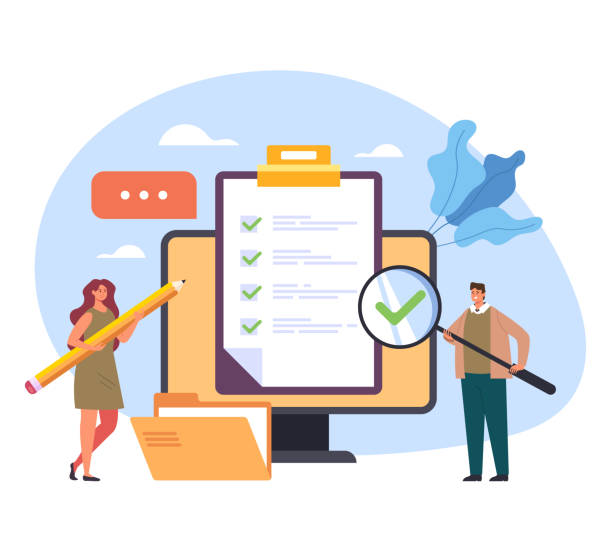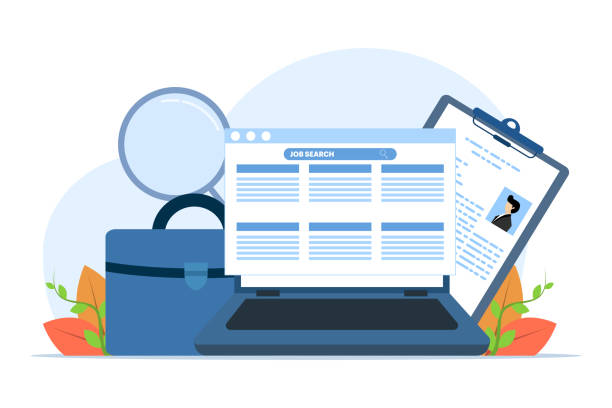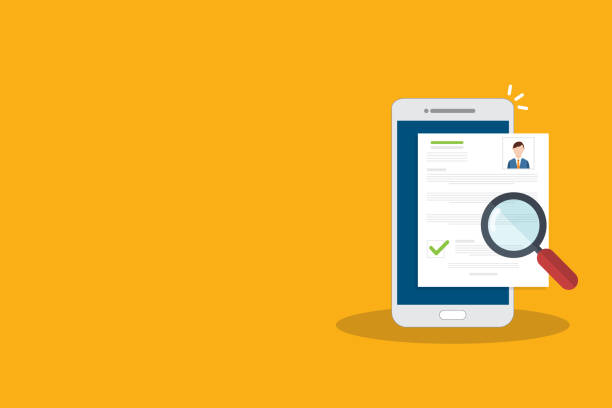Introduction to the Importance of User-Friendly Website Design

In today’s digital world, where competition for user attention is fiercer than ever, user-friendly website design is no longer a luxury option, but a vital necessity.
A poorly designed website can not only lose potential users but also severely damage your brand’s credibility.
The importance of User Experience (UX) and visual User Interface (UI) in attracting and retaining an audience is immense.
A website that is easy to navigate, provides information quickly, and offers an enjoyable experience will not only have higher conversion rates but also achieve a better ranking in Google search results.
#UserFriendlyWebsiteDesign means creating an online space where visitors feel comfortable and can easily achieve their goals.
This includes factors such as high loading speed, responsiveness across different devices, and logical information architecture.
Understanding these principles is the first step towards building a successful and sustainable digital platform.
Nielsen’s principles for user-friendly website design lead to increased customer satisfaction and loyalty.
This approach provides an explanation for understanding the importance of this fundamental concept in the web space and clarifies how it impacts the success of online businesses.
Do you dream of a thriving online store but don’t know where to start?
Rasaweb is your comprehensive e-commerce website design solution.
✅ Attractive and user-friendly design
✅ Increased sales and revenue⚡ Get Free Consultation
Fundamental Principles of User Experience (UX) in Web Design

User Experience (UX) goes beyond the visual aesthetics of a website; this concept addresses the overall feeling users have when interacting with the site.
Truly user-friendly website design is built upon fundamental UX principles, which include usability, accessibility, and desirability.
Usability means how easy it is for users to achieve their goals on the site; is the navigation logical? Is information easily found? Accessibility ensures that the site can be used by everyone, including people with disabilities.
This includes providing alternative text for images, supporting keyboard navigation, and appropriate color contrast.
Desirability also addresses the emotional aspects of interaction; is the site attractive, enjoyable, and trustworthy? In user-friendly website design, considering users’ needs, behaviors, and limitations at every stage of the design process is critically important.
This educational approach helps developers and designers look beyond appearance to the depth of the site’s functionality and feel.
The ultimate goal is to create a friction-less and enjoyable experience that encourages users to return and builds their trust.
Ultimately, focusing on these fundamental principles forms the cornerstone of a user-centered website design approach.
Attractive and Functional User Interface (UI)

While UX deals with the overall user experience, User Interface (UI) relates to the visual and interactive elements of a website.
Attractive and functional UI design plays a pivotal role in the success of any website, as it is the user’s first visual point of contact with your platform.
A successful user interface is not only beautiful but also intuitively understandable, helping the user easily navigate the site and access the information they need.
This includes the choice of colors, fonts, icons, buttons, and the layout of various elements on the page.
The main goal is for users to be able to achieve their objectives with minimal effort.
For example, Call-to-Action buttons should be clear and distinguishable.
A carefully designed UI can make the difference between a curious visitor and a loyal customer.
This specialized aspect of user-friendly website design requires deep knowledge in graphic design principles and visual psychology.
Maintaining visual consistency across all site pages, from branding to user experience, is crucial.
This table shows some of the best practices in UI design.
| UI Element | Importance | Example |
|---|---|---|
| Navigation | Easy access to different pages | Clear main menu, breadcrumbs |
| Font and Typography | Readability and text aesthetics | Choosing readable fonts, title hierarchy |
| Color Scheme | Visual appeal and user guidance | Consistent color palette, using color for important buttons |
| Images and Icons | Increased appeal and visual comprehension | Using high-quality images, standard icons |
| Forms and Inputs | Ease of information completion | Clear labels, input validation |
Loading Speed and Technical Optimization

One of the most crucial factors in user-friendly website design is page loading speed.
In today’s era, where users expect to receive information instantly, even a few seconds of loading delay can lead to loss of visitors and reduced conversion rates.
Research has shown that users quickly abandon slow-loading websites.
This not only negatively impacts user experience but is also a significant factor in search engine rankings (SEO).
Technical site optimization includes compressing images without reducing quality, using browser caching, optimizing code (HTML, CSS, JavaScript), and utilizing Content Delivery Networks (CDNs).
These guidelines help designers and developers maximize website performance.
In website design with a focus on user experience, attention to technical aspects is as important as visual design.
A fast website not only keeps users satisfied but also helps reduce server costs and improve overall site performance.
Ensuring that all site elements are optimized is an essential step towards providing a flawless user experience and directly impacts your online success.
Don’t have a corporate website yet and missing out on online opportunities? With professional corporate website design by Rasaweb,
✅ Double your business credibility
✅ Attract new customers
⚡ Free consultation for your corporate website!
Mobile Compatibility and Responsive Design

With the ever-increasing use of mobile phones to access the internet, user-friendly website design is almost impossible without considering mobile compatibility.
Responsive Design is a solution that ensures your website displays correctly and performs well on any device, from desktops to tablets and mobile phones.
This analytical approach emphasizes the importance of changing the layout and elements of the site based on the user’s screen size.
Lack of mobile compatibility can lead to a frustrating user experience; small texts, unclickable buttons, and difficult navigation are among the problems mobile users encounter, causing them to quickly leave the site.
Google, with its “Mobile-First Indexing” approach, first considers the mobile version of a site for indexing and ranking, which further emphasizes the importance of responsive design.
A website that is well-optimized for mobile not only increases accessibility but also helps improve SEO rankings and increase traffic.
Therefore, in the process of designing an easy-to-understand website, it should always be considered that a significant portion of your audience will access the site via mobile devices.
User-Friendly Content and Writing Strategy

Content is king, and this principle also applies to user-friendly website design.
Even the best UI design and technical performance will be useless if the site’s content is vague, disorganized, or irrelevant.
User-friendly content means information that is clear, concise, relevant, and presented with a logical structure.
This includes using simple language, avoiding unnecessary jargon, and dividing text into smaller, more readable paragraphs.
This section addresses thought-provoking content; does your content answer users’ questions? Does it meet their informational needs? Does it make them think?
A web writing strategy should include using engaging headings, bulleted lists, and clear calls-to-action.
Also, optimizing content for search engines (SEO Content) by using relevant keywords, without overdoing it, is crucial for your site’s visibility.
Users are looking for solutions and information, so your content should meet these needs.
A site with strong and user-friendly content encourages visitors to spend more time on the site, view more pages, and ultimately convert into customers.
Ultimately, the quality and relevance of the content not only improve the user experience but also highlight your credibility and expertise in your field.
The Importance of Accessibility for All Users

Accessibility means designing a website that can be used by everyone, regardless of their physical abilities or technical limitations.
This is an important ethical and legal aspect of user-friendly website design that is often overlooked.
Web accessibility laws and standards, such as the WCAG (Web Content Accessibility Guidelines), provide a comprehensive guide to ensure that websites are accessible to people with visual, auditory, motor, or cognitive disabilities.
For example, providing alternative text for images (Alt Text) allows users with screen readers to understand visual content.
Also, keyboard navigation capability is crucial for individuals who cannot use a mouse.
This educational approach emphasizes the importance of user-centered website design, ensuring that no group of users is deprived of access to information or services due to design flaws.
Accessibility not only benefits people with disabilities but also improves the user experience for everyone, such as users with slow internet or those in noisy environments.
An easy-to-understand website design demonstrates your commitment to inclusivity and equality and can significantly expand your user base.
The table below shows some key accessibility principles.
| Accessibility Principle (WCAG) | Explanation | Application Example |
|---|---|---|
| Perceivable | Information and user interface components must be presentable to users in ways they can perceive. | Alternative text for images, captions for videos. |
| Operable | User interface components and navigation must be operable. | Keyboard navigation, large and clickable controls. |
| Understandable | Information and the operation of user interface must be understandable. | Clear and simple language, error guidance. |
| Robust | Content must be robust enough that it can be interpreted by a wide variety of user agents. | Correct HTML code, use of ARIA roles. |
Usability Testing and User Feedback

Even the best designers cannot predict the needs and behaviors of all users.
Therefore, usability testing and gathering user feedback are crucial steps in the user-friendly website design process.
Usability testing involves observing real users interacting with your site to identify potential weaknesses and problems.
These tests can be conducted in person, remotely, or even using automated tools such as heatmaps and user session recordings.
The main goal is to discover obstacles that prevent users from achieving their objectives on the site.
In addition to formal tests, continuous feedback collection through surveys, contact forms, and social media monitoring is also very valuable.
This up-to-date information helps you identify unseen problems and implement necessary improvements.
User-experience-focused website design is an iterative process; every small improvement can have a significant impact on user satisfaction and, consequently, on your site’s success.
This analytical approach allows designers to test their assumptions and use real data for continuous site optimization.
Did you know that a weak corporate website costs you many opportunities daily? Solve this problem forever with professional corporate website design by Rasaweb!
✅ Create a powerful and trustworthy image for your brand
✅ Attract targeted new customers and increase sales
⚡ [Get Free Website Design Consultation]
Data Analysis and Continuous Improvement

After launching a website with user-friendly website design, your work has just begun.
To ensure continuous effectiveness and ongoing optimization, detailed data analysis is essential.
Tools such as Google Analytics, Google Search Console, and other analytical tools provide valuable insights into user behavior on your site.
This data includes visited pages, time spent on site, bounce rate, and user navigation paths.
By analyzing this data, you can identify the strengths and weaknesses of your design.
For example, a high bounce rate on a specific page might indicate irrelevant content or difficult navigation.
Low time on site could mean unengaging content or slow loading speed.
These analyses give you an analytical approach to make data-driven decisions for improving your easy-to-understand website design.
Continuous improvement in user-centered website design is an endless cycle of measurement, analysis, and implementation of changes.
The ultimate goal is for every small change to enhance the user experience and move closer to your business objectives.
This dynamic process ensures that your site always remains compatible with changing user needs and web standards.
Future Trends in User-Friendly Website Design

The world of the web is constantly evolving, and with the emergence of new technologies, the concept of user-friendly website design also evolves.
In the future, we will see a greater impact of Artificial Intelligence (AI), personalization, Voice UI, and Augmented/Virtual Reality (AR/VR) on user experience.
AI can help websites personalize content and experiences based on each user’s unique behavior and preferences, which significantly increases user satisfaction.
Voice user interfaces enable interaction with websites without the need for typing, which is more convenient for many users.
Augmented and virtual reality can offer immersive experiences, especially in e-commerce and education.
These future trends indicate that user-centered website design will increasingly move towards natural and intuitive interactions.
For designers and developers, it is essential to become familiar with these emerging technologies and integrate them into their design process.
The ultimate goal is for websites to be not only user-friendly but also predictive of user needs and actively participate in providing solutions and information.
This engaging and forward-looking section introduces you to new horizons in easy-to-understand website design and helps you prepare for future challenges and opportunities.
Frequently Asked Questions
And other services of Rasa Web Advertising Agency in the field of advertising
Smart Marketing Automation: A novel service to increase digital branding through SEO-driven content strategy.
Smart Website Development: A specialized service for online growth based on precise audience targeting.
Smart Brand Identity: A creative platform to improve website traffic with Google Ads management.
Smart SEO: An effective tool for digital branding with the help of attractive UI design.
Smart Link Building: Transform SEO ranking improvement by utilizing real data.
And over hundreds of other services in the field of internet advertising, advertising consultation, and organizational solutions
Internet Advertising | Advertising Strategy | Advertorial
Resources
UI/UX Design Principles in WebsiteSEO Guide for BeginnersKey Tips for Improving User ExperienceOnline Marketing Strategies for Success
? Ready for sustained brilliance and growth in the digital world? Rasaweb Afarin Digital Marketing Agency, with its expertise in providing comprehensive services including SEO-optimized website design, Search Engine Optimization (SEO), and targeted advertising campaigns, is your reliable partner on the path to online success.
📍 Tehran, Mirdamad Street, next to Bank Markazi, Kazeroun Jonoubi Alley, Ramin Alley, No. 6



